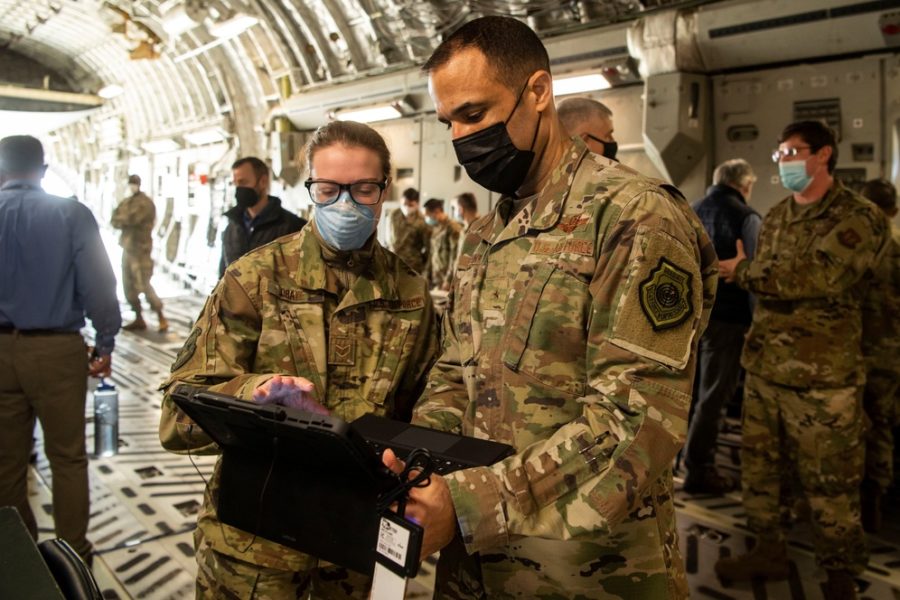An initial team of Parsons employees arrived at Ramstein Air Base, Germany, on Nov. 15, and its members are now working daily with U.S. Air Forces in Europe-Air Forces Africa, designing a plan to better defend U.S. air bases in the European and African theaters.
The move comes about three months after Parsons received a 10-year, nearly $1 billion indefinite-delivery, indefinite-quantity Air Base Air Defense contract to “design, mature, procure, integrate, operate, and maintain Air Base Air Defense (ABAD) systems” across USAFE-AFAFRICA, according to a company release.
The government wants a mix of sensors and kinetic and nonkinetic systems that can find, fix, track, target, engage, and assess a range of threats, from small unmanned systems to hypersonic missiles.
Shaun McGrath, Parsons’ ABAD program manager, told Air Force Magazine the team will initially focus on establishing the requirements necessary to carry out the first phase of the contract.
In Phase 1, Parsons will help establish the Ramstein Air Defense Systems Integration Lab, or RADSIL, at Ramstein. The lab will be operated by Airmen and serve as the command and control center for air base defense operations in the European and African theaters.
The goal is to build an integrated system of systems that uses both commercial and government off-the-shelf software and hardware to help the service digest mass amounts of data that can be replicated at other locations and potentially on an expeditionary basis. That’s a key factor as the Air Force moves toward a more distributed concept of operations, known as agile combat employment.
“It’s much like me showing up in a location, trying to figure out how we’re going to do a bare base stand up. This is the same thing,” McGrath said. “It’s how do you get everybody to work together? How do you figure out what the actual requirements are? And, how do you start to phase that in so we can actually, successfully get into Phase 1.”
Rapidly Evolving Threat
Gen. Jeffrey L. Harrigian, commander of USAFE-AFAFRICA, told reporters at AFA’s Air, Space & Cyber Conference in September that threats—especially those from Russia—were evolving so rapidly, the Air Force needed a better way to defend its larger bases as well as the more austere locations it will be operating.
“We had to accept the fact that we probably weren’t in the position we wanted to be,” Harrigian said. So, in February, the command launched an initial demonstration to try to determine what sensors were already available and then try to find a way to fuse that data “into a picture that then was supported by decision-making tools to minimize the number of people required to do this mission set. That’s kind of our goal. We recognize that you can’t have a whole bunch of people doing this or it will never get resourced,” Harrigian told reporters at the conference.
McGrath said Parsons and its industry partners are building upon and then operationalizing USAFE’s original efforts.
Harrigian said one of the big challenges will be finding cross-domain solutions capable of crossing various classification levels and then figuring out how to filter that through a decision-making algorithm that uses emerging technologies, such as artificial intelligence.
“So that’s where we’re starting with them,” Harrigian said, referring to the Parsons team. “And, clearly, as we go through the budgetary side of it, this is what we’re communicating back up to the Air Force to figure out, ‘OK, how do we turn that big idea, the [concept of operations], into a level of funding that is scalable and tailorable for the broader Air Force. There’s still some decisions to be made there, and I don’t want to get in front of everybody, but I think the conversation is going in the direction that I expected it to, which is some of this we’re gonna have to figure out.”
Although Ramstein will remain the Air Base Air Defense hub, Harrigian said Aviano Air Base, Italy, is “the next place I’d like to go.” However, as of September, agreements with the host country were still being worked out.
“I am in the camp of, ‘Let’s go faster on this,’ because I think it’s inside of the price point that should make it affordable for us to expand this at a speed that gets after what [Chief of Staff] Gen. [Charles Q.] Brown is pushing to accelerate change,” Harrigian said.
